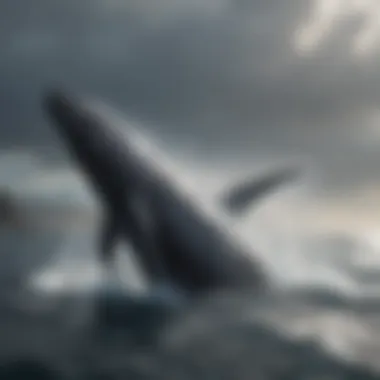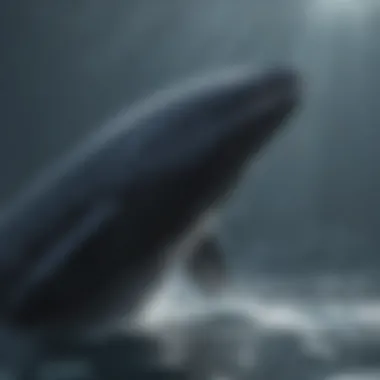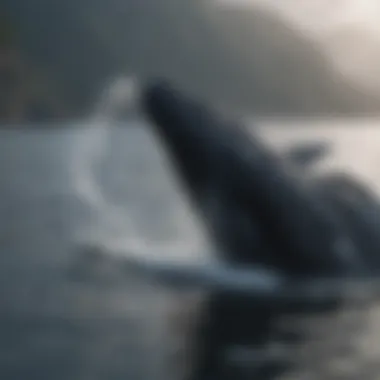Deep Dive into the Enigmatic World of Whale Populations Across the Vast Oceans


Animal Species Profile
Whales, the majestic marine mammals of the ocean, are a subject of fascination for many nature enthusiasts and conservationists alike. Their sheer size and gentle nature make them a captivating species to study. Whales, known for their streamlined bodies and iconic spout, inhabit the world's oceans, thriving in both cold and warm waters. These creatures exhibit complex social behaviors, often traveling in family pods and communicating through intricate underwater vocalizations.
Conservation & Wildlife Efforts
The conservation status of whales is a critical concern due to various threats they face in their natural habitat. Factors such as pollution, climate change, and commercial whaling have endangered several whale species. Conservation initiatives led by organizations like the World Wildlife Fund and Oceana aim to protect whale populations through research, advocacy, and policy changes. Success stories, such as the recovery of certain whale species due to conservation efforts, highlight the positive impact of dedicated wildlife conservation.
Animal Behavior & Psychology
Whales exhibit remarkable communication skills, utilizing a combination of vocalizations, body language, and tail slaps to interact with each other. Their reproductive behavior involves intricate courtship rituals and maternal care, ensuring the survival of their offspring. Studies have shown that whales possess advanced cognitive abilities, showcasing problem-solving skills and emotional intelligence in complex social environments.
Unique Facts & Trivia
Did you know that some whale species undertake the longest migration of any mammal, traveling thousands of miles annually? Whales display unique behaviors such as breaching, spy-hopping, and bubble-net feeding, showcasing their adaptive evolution. Fun trivia includes the fact that the blue whale, the largest animal on Earth, has a heart the size of a small car. Record-breaking feats like the deep-diving abilities of sperm whales add to the mystique and wonder surrounding these fascinating creatures.
Introduction to Whales
Whales, the majestic giants of the ocean, play a pivotal role in the marine ecosystem. In this article, we embark on a journey to explore the nuances of these captivating creatures. Understanding the importance of whales goes beyond their sheer size; it encompasses their cultural significance, ecological impact, and conservation implications. Delving into the world of whales reveals a complex tapestry of species, behaviors, and interactions that shape the world beneath the waves. Appreciating the diversity of whales is not merely a scientific endeavor but a profound dive into the interconnectedness of all life forms on our planet.
Understanding Whale Diversity
The Various Whale Species
Diving into the depths of whale diversity unveils a myriad of species that roam the oceans. Each species, from the massive blue whale to the acrobatic humpback, brings unique characteristics to the table. The sheer variety of behaviors, feeding habits, and migratory patterns among whales underscores their adaptive evolution. Exploring the various whale species provides a holistic understanding of the biodiversity thriving in our oceans.
Distinctive Characteristics of Whales
Whales possess distinctive characteristics that set them apart in the marine world. Their streamlined bodies, echolocation abilities, and massive sizes stand out as evolutionary marvels. These characteristics not only define whales as a group but also offer insights into their ecological roles and survival strategies. Understanding the distinctive features of whales sheds light on their adaptations to the marine environment and the challenges they face in a changing world.


Role of Whales in Marine Ecosystems
Impact on Ocean Health
Whales wield a profound impact on ocean health, functioning as ecosystem engineers that regulate food webs and carbon cycles. Their movements and feeding behavior influence the distribution of marine species and the overall balance of marine ecosystems. By fertilizing surface waters with their nutrient-rich excrement, whales promote phytoplankton growth, which in turn sequesters carbon and sustains marine life. Recognizing the critical role of whales in ocean health underscores the need for their protection and conservation.
Significance of Whales in Food Chains
Whales occupy a significant position in marine food chains, serving as top predators that help maintain ecosystem stability. Their consumption of large quantities of prey species regulates population sizes and keeps marine ecosystems in equilibrium. Moreover, whales act as indicators of ocean health, reflecting the state of marine resources and environmental conditions. Appreciating the significance of whales in food chains highlights the intricate connections that define marine life and the delicate balance that sustains our oceans.
Factors Affecting Whale Populations
Whale populations in the ocean are intricately influenced by various factors which play a pivotal role in shaping their numbers and distribution. Understanding these factors is crucial for devising effective conservation strategies to ensure the survival of these magnificent marine creatures. Factors like human activities and the effects of climate change have significant implications for whale populations, highlighting the delicate balance of marine ecosystems.
Human Activities
Human activities have had a profound impact on whale populations throughout history. Whaling History stands as a contentious issue, marked by centuries of human exploitation of whales for various purposes. The key characteristic of Whaling History lies in its historical significance and the widespread practice of hunting whales for their meat, blubber, and other resources. While Whaling History may have provided economic benefits in the past, its unsustainable nature has led to a drastic decline in whale populations, raising ethical concerns among conservationists.
Moving on to Threats from Pollution, it is essential to recognize the detrimental effects of human-induced pollution on whales and their habitats. Pollution from sources such as marine litter, plastic waste, and chemical contaminants poses a severe threat to whale populations, impacting their health and reproductive capabilities. The key characteristic of Threats from Pollution is its insidious nature, silently affecting whales and other marine organisms without immediate visibility. Addressing pollution issues is imperative for safeguarding whale populations and preserving the ecological balance of the oceans.
Climate Change Effects
Climate change exerts a significant influence on whale populations through its effects on marine environments. Impact on Habitat is a crucial aspect that underscores the direct consequences of rising ocean temperatures and changing currents on whale habitats. The key characteristic of Impact on Habitat lies in its ability to alter the availability of prey species and disrupt established feeding grounds, forcing whales to adapt to shifting environmental conditions. While whales display resilience to some extent, prolonged habitat degradation could jeopardize their survival.
In addition, Altered Migration Patterns reflect the complex repercussions of climate change on whale behavior and distribution. The key characteristic of Altered Migration Patterns is the disruption of traditional migration routes due to changing oceanic conditions, leading to potential conflicts with human activities such as shipping and fishing. Understanding and monitoring these altered patterns are essential for predicting future trends in whale movements and implementing measures to mitigate adverse impacts.
These factors interplay intricate dynamics in shaping whale populations, underscoring the need for continued research, conservation efforts, and global cooperation to protect these majestic creatures and preserve the biodiversity of the oceans.
Conservation Efforts for Whale Protection
In this segment, we delve into the critical sphere of Conservation Efforts for Whale Protection, an indispensable aspect in safeguarding the delicate balance of the marine ecosystem. The preservation of whale populations not only ensures the continuity of these majestic creatures but also plays a vital role in maintaining the health and stability of the oceans. Conservation efforts encompass a spectrum of interventions aimed at mitigating threats like habitat destruction, pollution, and climate change that endanger whale populations. By addressing these issues through dedicated initiatives and global collaboration, the world can strive towards ensuring a sustainable future for whales and the marine environment.


Global Conservation Initiatives
International Whaling Commission
The International Whaling Commission is a pivotal entity dedicated to the regulation of whaling activities globally. Its primary goal is to establish frameworks for the sustainable management of whale stocks, reducing the impact of whaling on whale populations. Through the implementation and enforcement of quotas and moratoriums, the commission aims to curb excessive hunting and protect vulnerable whale species. Despite facing challenges and criticism, the IWC remains a cornerstone of international efforts to conserve whales and uphold ethical whaling practices.
Marine Protected Areas
Marine Protected Areas serve as sanctuaries for marine life, including whales, by granting legal protection to specific ocean regions. These designated areas restrict human activities like fishing and shipping that can disturb marine ecosystems. By safeguarding crucial habitats and migration routes, Marine Protected Areas contribute significantly to the conservation of whale populations. The strategic placement of these zones helps preserve biodiversity and provides essential breeding and feeding grounds for whales, thereby fostering long-term sustainability.
Community-Based Conservation Projects
Local Engagement for Whale Conservation
Local Engagement for Whale Conservation involves the active participation of coastal communities and stakeholders in protecting whale populations. This grassroots approach empowers local residents to contribute to conservation efforts by monitoring whale sightings, reporting stranding events, and promoting responsible boating practices. By fostering a sense of stewardship within communities, this initiative instills a deeper connection with whales and the marine environment, fostering a culture of conservation and respect.
Promoting Sustainable Whale Watching
Promoting Sustainable Whale Watching advocates for responsible tourism practices that minimize disturbance to whales and their habitats. This approach emphasizes regulations on vessel behavior, viewing distances, and tour operations to ensure whale welfare is prioritized. By promoting eco-friendly whale watching experiences, this initiative not only supports local economies but also raises awareness about the importance of ethical wildlife encounters. Through educational programs and collaboration with tour operators, sustainable whale watching plays a crucial role in promoting conservation ethics and fostering a harmonious coexistence between humans and whales.
Current Status of Whale Populations
In this article, delving into the population of whales in the vast ocean, examining the current status of whale populations proves to be pivotal. Understanding the dynamics of whale populations is essential for grasping the intricate balance within marine ecosystems. By exploring the population trends and challenges faced by conservationists, we can better appreciate the complexities linked to the conservation efforts. Monitoring the fluctuations in whale numbers and behavior provides crucial insights into the health of the ocean's ecosystems.
Population Trends
Key Findings from Research Studies
Exploring the key findings from research studies offers a gateway into comprehending the ever-changing landscape of whale populations. Research findings play a vital role in shaping conservation strategies and policies. By analyzing the data collected from these studies, researchers can identify trends in whale populations, including fluctuations in numbers and migration patterns. Understanding these trends is crucial for implementing effective conservation measures tailored to the specific needs of different whale species.


Monitoring Whale Populations
Monitoring whale populations is a fundamental aspect of wildlife conservation. Through innovative monitoring techniques, researchers can track the movements and behaviors of whales, gaining insights into their habitat preferences and feeding habits. This data is valuable for assessing the impact of human activities on whale populations and designing conservation initiatives to mitigate potential threats. However, challenges such as the vast expanse of the ocean and the elusive nature of whales make monitoring a complex and resource-intensive task.
Challenges for Conservationists
Balancing Commercial Interests
The balancing act between conservation efforts and commercial interests poses a significant challenge for conservationists. In many regions, economic activities such as fishing and shipping compete with conservation goals, leading to conflicts over resource allocation. Finding a harmonious balance that prioritizes both environmental sustainability and economic prosperity is essential for ensuring the long-term survival of whale populations. Conservationists must navigate these competing interests while advocating for policies that safeguard the welfare of marine ecosystems.
Ensuring Sustainable Practices
Ensuring that conservation practices are sustainable is paramount for the protection of whale populations. Sustainable practices entail using resources in a manner that meets present needs without compromising the ability of future generations to meet their own needs. Conservationists must promote sustainable fishing methods, reduce pollution levels in the oceans, and minimize human disturbance in whale habitats. By implementing sustainable practices, conservationists can safeguard the delicate ecosystems that whales rely on for survival.
Future Prospects for Whale Conservation
In this pivotal section of the article focusing on the 'Future Prospects for Whale Conservation,' the imperative need to explore innovative strategies for safeguarding whale populations comes to the forefront. Shedding light on the evolving landscape of conservation efforts, this segment delves into the specific elements, benefits, and considerations pertinent to ensuring the longevity and well-being of these majestic marine creatures. By examining technological advancements, educational outreach, and community engagement, this article lays the foundation for a forward-looking approach to whale conservation.
Technological Innovations
Advances in Monitoring Techniques
Within the realm of technological innovations, the discussion centers on the crucial aspect of advances in monitoring techniques and their substantial contribution to the overarching goal of whale conservation. Highlighting the cutting-edge methods employed in tracking and studying whale populations, this subsection underscores the precision, efficiency, and reliability that characterize advanced monitoring techniques. By elucidating the nuances of these methodologies and their role in informing conservation strategies, this article underscores the unparalleled value they bring to the table.
Utilizing Drones for Research
Exploring the transformative impact of utilizing drones for research purposes, this subsection emphasizes the revolutionary nature of employing unmanned aerial vehicles in studying whale behavior and habitats. By accentuating the flexibility, cost-effectiveness, and non-intrusive nature of drone-based research, this article underscores the significant advantages they offer in expanding our understanding of whale populations. Despite inherent challenges and limitations, drones emerge as a promising tool for enhancing research precision and generating actionable insights in the realm of whale conservation.
Educational Outreach
Raising Awareness on Whale Conservation
Within the domain of educational outreach, the spotlight falls on the pivotal role of raising awareness on whale conservation and its paramount contribution to the overarching goals of environmental stewardship. By elucidating the power of education in fostering compassion, advocacy, and behavioral change, this subsection underscores the critical importance of public engagement in safeguarding whale populations. Through targeted campaigns, informative resources, and collaborative initiatives, raising awareness emerges as a linchpin in driving meaningful conservation outcomes.
Incorporating Conservation in School Curricula
Delving into the realm of formal education, this subsection explores the significance of incorporating conservation principles into school curricula to nurture a future generation of environmentally conscious citizens. By highlighting the curricular enhancements, multidisciplinary approaches, and experiential learning opportunities associated with conservation integration, this article underscores the transformative potential of education in shaping attitudes and behaviors towards whale conservation. Despite inherent challenges and systemic barriers, the integration of conservation themes in educational settings promises to sow the seeds of sustainability and ethical stewardship among young learners.







